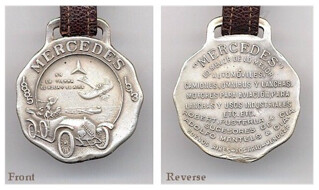
PREV ARTICLE
NEXT ARTICLE
FULL ISSUE
PREV FULL ISSUE
ARE WATCHFOBS NUMISMATIC?
Dick Johnson poses this question for our readers. Are watch fobs numismatic? Here's his account of a recent encounter with a museum display of watch fobs.
Now, I know what some of you are thinking - "What the heck is a watch fob?" First, I suppose, I may have to explain what a 'watch" is. It's an old fashioned timepiece carried in a pocket or worn on a wrist. Pre-electronic era, they ran on energy stored up inside the housing by physically winding a stem on the watch - no batteries or photocell required. Pocket watches were often secured by a small chain. Sometimes an ornament or seal was attached the watch chain. These were called "watch fobs" or "watchfobs". Below is an image of an early Mercedes automobile advertising watch fob. Sorry if this reads like sarcasm to many of you, but the younger generation may truly require some background explanation. I know this because my kids tell me things like "There's always been an Internet" and "There've always been cell phones". -Editor

I visited a museum this week and asked to see the items in one particular display case -- a group of colorful watchfobs. I do this frequently when visiting a new museum. I get turned down perhaps half the time, but I found in small museums, particularly when I can ask permission from the top honcho permission is granted. It is worthwhile to ask even for success half the time. My son and family were visiting for Easter week. Six-year-old grandson is fascinated with trains. When a train museum was mentioned it became a unanimous choice for a family visit. Tucked in a corner I found the display of 32 watchfobs, every one in colorful enamel of a different railroad. All save for one, it was Clabber Girl baking power. I asked the attendant for permission to examine each of these to see if they were signed by a maker on the reverse. "I can't grant permission, but the chairman is in the train yard I will go ask him." In the past I have dealt with directors, chief curators and others, but this was a first. I had to get permission from the chairman. Minutes later he arrived. After introductions and a brief recital of my credentials and the reason why I wanted to see the reverse of each of those watchfobs, he became enthused to learn more about the watchfobs himself. Fortunately a worktable was in the center of the room and they brought me a handful, all 32 watchfobs, to examine. I turned over the first to find a large inscription: "A CLASSIC ISSUE." Strange I thought, but the second and all the rest bore the same inscription (except for Clabber Girl). Then I realized these were all reproductions, copies, not originals. "These are all reproductions" I informed the chairman. "Worth less than $100. If they were genuine they would be worth between $1,000 and $1,500." "I don't care about value. They make a good display." On that point he was correct. With train logos, famous railroad names, and color enamel they were excellent showpieces.. Evidently the donor thought that as well. He had one watchfob (Clabber Girl) admixed in a group of 31 railroad items. Which brings me to my question: Are watchfobs numismatic? I lean to saying "yes." They are diestruck, made by the same companies (usually) who are also private mints or medal makers. Same engravers, struck on same presses, same metal compositions (even silver and gold!). Often given a finish similar to medals. Most watchfobs are uniface (only the side exposed). They must have a wide loop at the top for the leather strap (called a fob loop). I have never seen one signed by the original artist, but frequently signed by the maker (name or logo). Whitehead & Hoag in Newark, Greenduck of Chicago, Robbins and Metal Arts were all major manufacturers. Tiffany & Co made one in 1881. Watchfobs were often sold or given away at expos, fairs or conventions. They were highly popular in the 1890s which continued to the 1930s. All men's pants had a small pocket below the belt. That's where the owner kept his pocket watch. The fob was connected to a leather strap connected to the watch. To retrieve the watch it was an easy task via a tug on the leather strap and watchfob. Two things killed watchfobs, the depression of that decade, but more importantly was the rise of the wristwatch. Watchfobs are collected There are societies of fob collectors. And guess what -- they are collected by topics much like medals. But since this was a male dominated custom, the topics are strongly male oriented. Train conductors had to have them, so railroad and transportation are strong fob topics. So is construction equipment, trucking and farm equipment, military veteran and fraternal organizations. Companies had these made often with their logos and gave them to customers and employees as advertising. Today watchfobs are a faded custom of America's past, but of strong collector interest. Not quite a token, but classed along with other exonumia material. Numismatic or not, your choice.
But what about that Clabber Girl fob? Nice logo of a baking powder can in color on white enamel background with red enamel lettering. The tiniest makers name on reverse: "BY GEO / MITA[?] OHIO."
The Numismatic Bibliomania Society is a non-profit organization promoting numismatic literature. See our web site at coinbooks.org. To submit items for publication in The E-Sylum, write to the Editor at this address: whomren@gmail.com To subscribe go to: https://my.binhost.com/lists/listinfo/esylum All Rights Reserved. NBS Home Page Contact the NBS webmaster 
|